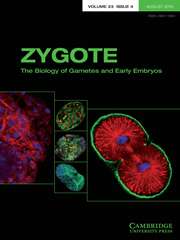Article contents
Bovine ICSI: limiting factors, strategies to improve its efficiency and alternative approaches
Published online by Cambridge University Press: 09 September 2022
Summary
Intracytoplasmic sperm injection (ICSI) is an assisted reproductive technique mainly used to overcome severe infertility problems associated with the male factor, but in cattle its efficiency is far from optimal. Artificial activation treatments combining ionomycin (Io) with 6-dimethylaminopurine after piezo-ICSI or anisomycin after conventional ICSI have recently increased the blastocyst rate obtained. Compounds to capacitate bovine spermatozoa, such as heparin and methyl-β-cyclodextrin and compounds to destabilize sperm membranes such as NaOH, lysolecithin and Triton X-100, have been assessed, although they have failed to substantially improve post-ICSI embryonic development. Disulfide bond reducing agents, such as dithiothreitol (DTT), dithiobutylamine and reduced glutathione, have been assessed to decondense the hypercondensed head of bovine spermatozoa, the two latter being more efficient than DTT and less harmful. Although piezo-directed ICSI without external activation has generated high fertilization rates and modest rates of early embryo development, other studies have required exogenous activation to improve the results. This manuscript thoroughly reviews the different strategies used in bovine ICSI to improve its efficiency and proposes some alternative approaches, such as the use of extracellular vesicles (EVs) as ‘biological methods of oocyte activation’ or the incorporation of EVs in the in vitro maturation and/or culture medium as antioxidant defence agents to improve the competence of the ooplasm, as well as a preincubation of the spermatozoa in estrous oviductal fluid to induce physiological capacitation and acrosome reaction before ICSI, and the use of hyaluronate in the sperm immobilization medium.
Keywords
Information
- Type
- Review Article
- Information
- Copyright
- © The Author(s), 2022. Published by Cambridge University Press
References
- 8
- Cited by

